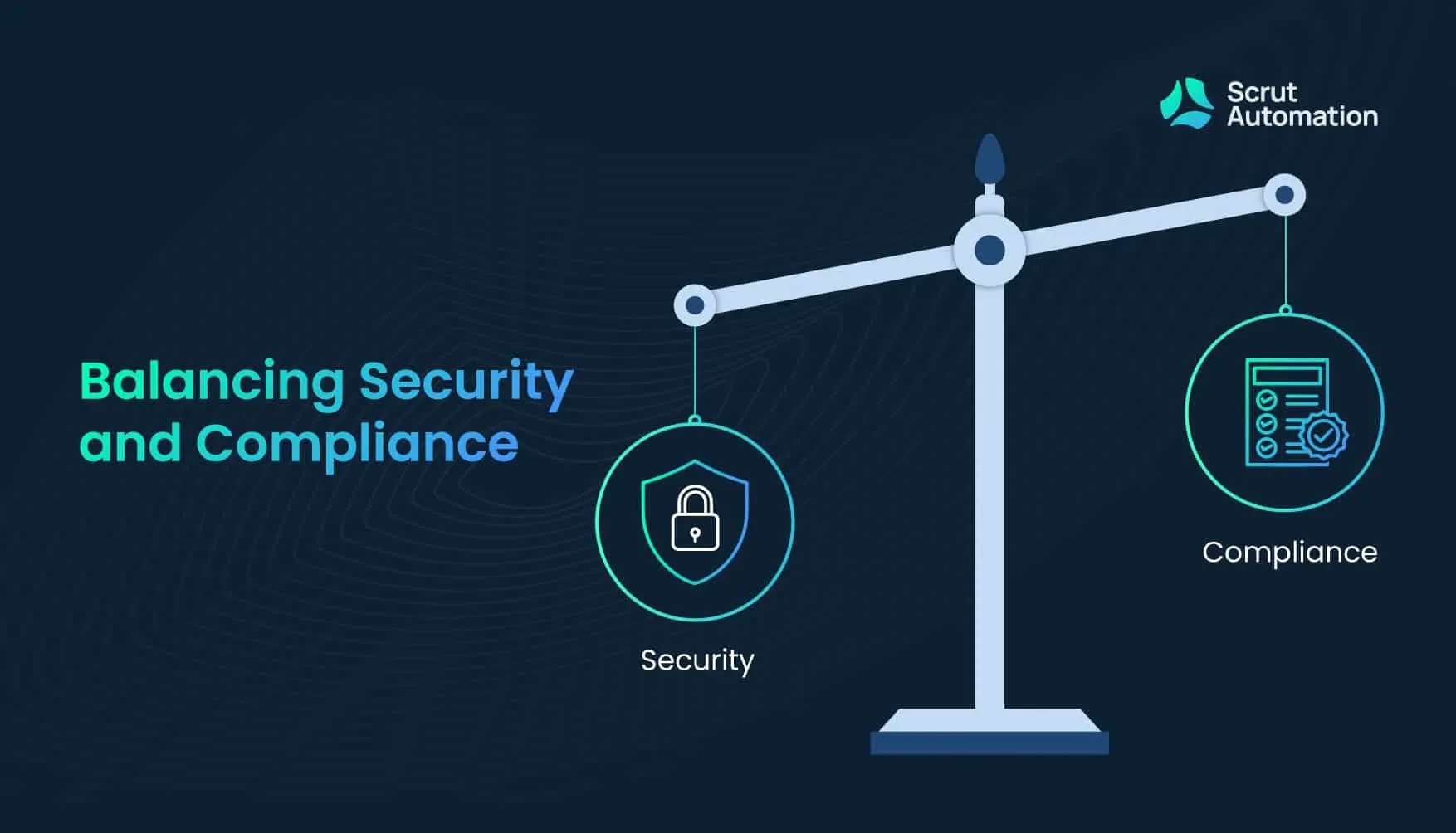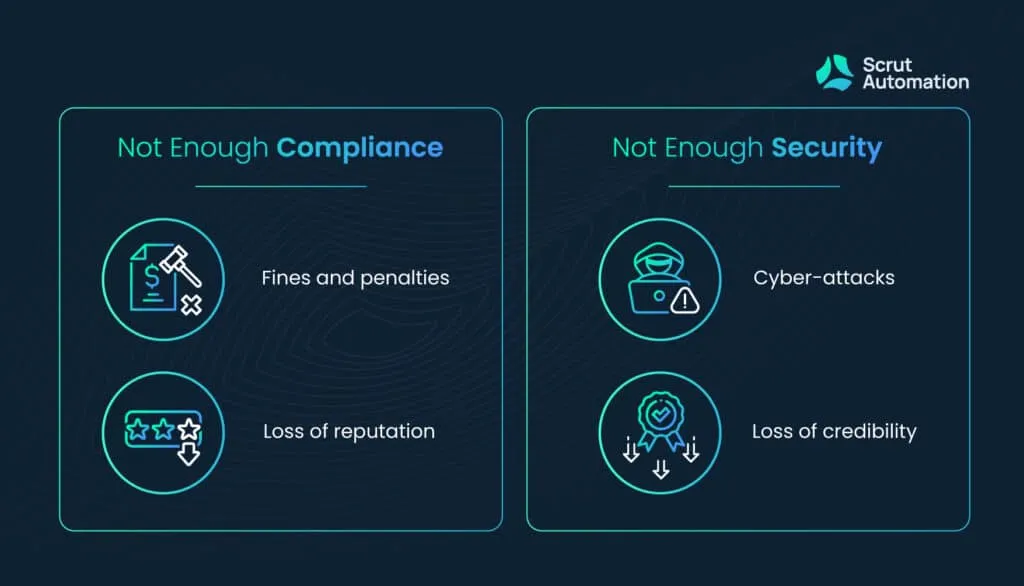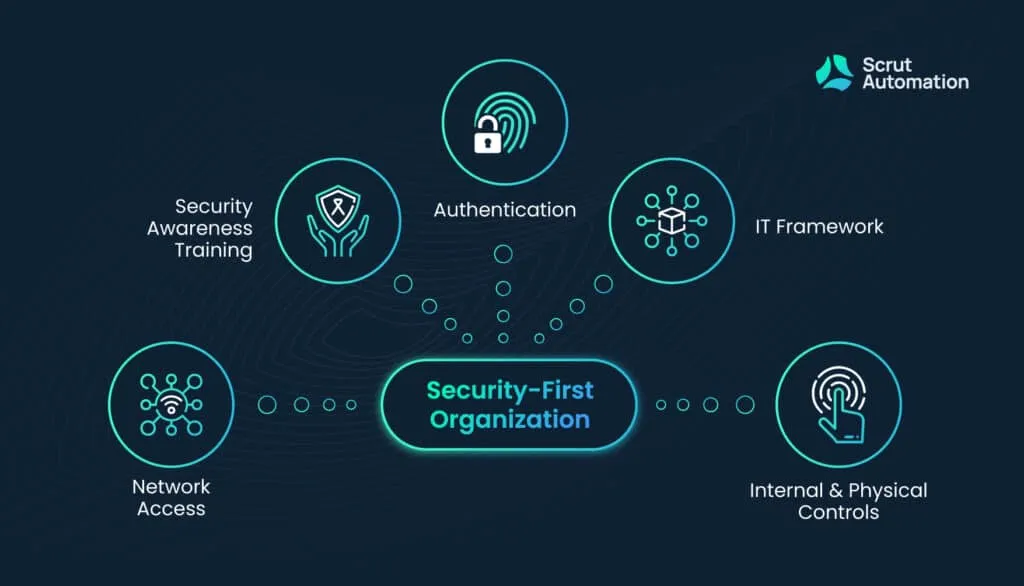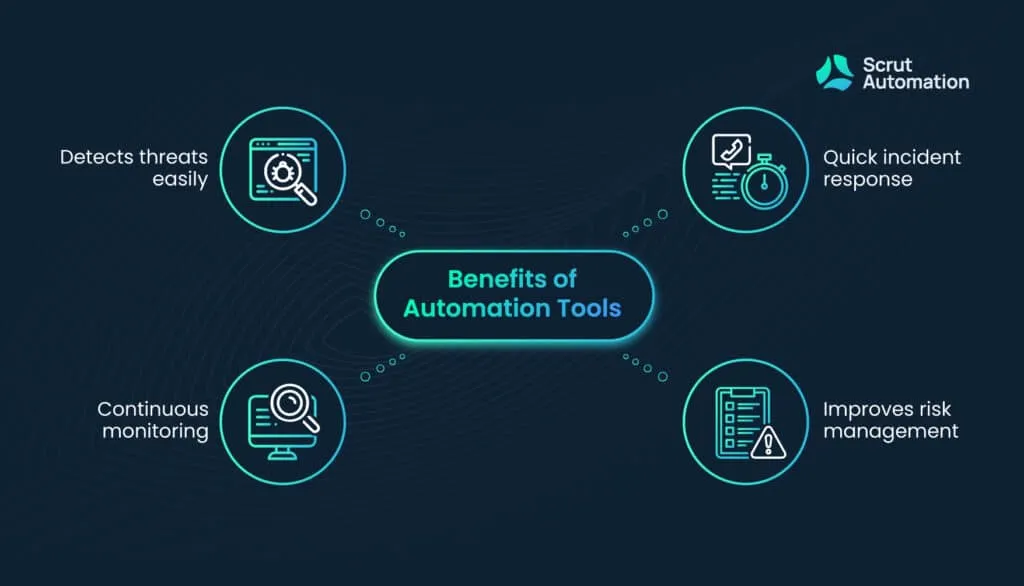How to Prevent Cyberattacks by Balancing Security and Compliance?

Security and compliance are the two main indicators of an organization’s safety. A company that is not secure will constantly be under threat of cyber attacks, while a company that is not compliant unconsciously declares to the world that it is unsafe to do business with.
The two are often confused with one another, but it is important to understand that compliance and security are not the same.
Compliance tends to focus on the implementation of controls to complete certification against leading industry standards and frameworks, while security focuses its efforts on protecting these controls and maintaining compliance to fight against cyber attacks.
Today, organizations are confronted by countless security threats as well as increasing security regulations. Optimizing both cybersecurity and compliance will guarantee that your organization’s security as well as reputation is taken care of.
If you would like to learn how to protect yourself from cyberattacks, figuring out how to strike a balance between security and compliance is the best way to go.
The difference between security and compliance

Compliance focuses on satisfying the security requirements of external regulatory bodies and industries. For instance, organizations with operations in Europe adhere to GDPR, while medical companies adhere to HIPAA.
The process of compliance involves taking steps such as evidence collection, policy development, and control mapping in order to pass audits.
Compliance requirements are increasing by the day, and preparing for these audits uses up a lot of time and resources. If an organization does not pass an audit, it is forced to pay fines and loses its reputation.
On the other hand, security focuses on actively defending an organization against cyber attacks that threaten its assets. It is a constant effort since security threats can strike at any time, without warning.
The failure to implement proper security will result in security breaches that invade, leak, alter, or destroy a company’s assets.
Recovering from an attack is a costly affair. Companies can lose a significant amount of revenue when there is a data breach. They may need to shut down for days to recover. Loss of intellectual property, destruction of cyber assets, and data leaks are some of the brutal consequences of a breach. All this leads, in turn, to the organization losing its credibility.
Consequences of placing security over compliance
Security takes a more holistic approach than compliance when it comes to safety. It takes into account every asset and vulnerability for effective risk management, while a compliance-focused approach focuses on having the right security controls to pass audits.
Efficient security will result in compliance as a byproduct. However, when an organization focuses solely on security, without proving its compliance in audits, it is bound to be penalized.
Every organization has to follow regional and industrial security standards in order to be deemed compliant. This can be a time-consuming process, which some organizations may fail to carry out regularly if their focus is on security alone.
Even if a company has the most resilient security architecture and knows how to prevent ddos attacks and vicious malware, if it focuses all its resources solely on cybersecurity and ignores reporting functions such as collecting evidence for passing compliance audits, it will be pronounced non-compliant by regulatory bodies.
A non-compliant company is not a credible one, and customers, investors, and vendors will refrain from associating with it.
Consequences of placing compliance over security

Organizations that prioritize compliance over security invest too much time and resources in trying to look secure on paper instead of actually being secure.
These companies do not allocate enough resources to security operations. This results in gaps in its security architecture, which allow security threats to waltz right in.
Compliance frameworks do provide useful steps in improving an organization’s security posture. Unfortunately, even compliance frameworks that prescribe the best industry practices, such as SOC2, are not enough to tackle the current threat landscape.
This is because compliance frameworks are developed and updated only once in a while. Sometimes it takes years for a framework to be updated. The threat landscape and the security tool landscape, on the other hand, change by the day.
Due to this, cyberattack prevention and resolution by compliant-first companies are not adequate. Such companies become easy targets for security threats and end up crumbling when hit by a cyberattack.
Striking a balance between compliance and security to prevent cyberattacks
By figuring out the right balance between security and compliance, an organization can not only prevent cyber attacks but also keep customers, investors, and regulatory bodies satisfied.
Here are some ways in which an organization can balance the two and get the best out of both.
Use a security-first approach

Though both compliance and security are important, security is crucial for an organization’s safety. This is because security keeps an eye out for security threats at all times.
A company with strong security has the ability to prevent and resolve security breaches, mitigate their impact and recover cyber assets that are affected by them.
When a company puts security first, it uses technology such as the best malware protection, encryption tools, and firewalls to guard cyber assets.
It also has in place the best controls and strategies such as zero trust that make it difficult for hackers to break in.
A security-first approach integrates security into every operation and decision. All employees in a security-first company go through cybersecurity awareness training to avoid security incidents.
Companies can no longer afford to treat security as a regulatory requirement due to the ever-advancing threat landscape.
However, this is not to say that compliance should be put on the back burner. In fact, a security-first approach guarantees compliance. When a company follows the best security practices, it satisfies compliance requirements as well.
Compliance is, after all, following security standards that are prescribed by an external body. A company with good security will inevitably fulfill these requirements. All that is left for it to do is present the evidence of its efforts to pass compliance audits.
Maximize security by using compliance as a baseline

Some organizations find it easier to follow compliance frameworks than to come up with a security plan that suits their needs. They do not know where to begin or how to go about enforcing security.
Following compliance standards lulls them into a false sense of security. As mentioned before, compliance frameworks have outdated security standards. An organization that solely fulfills compliance requirements doesn’t stand a chance in today’s threat landscape.
However, there are compliance frameworks that prescribe useful security measures. They may not be the most effective when it comes to tackling current security issues, but they do act as a good foundation for a security program.
Frameworks such as SOC 2 provide very useful security practices. They are great baselines to build security on. Gaps in these frameworks should be filled using the latest security technology and processes in order to prevent cyber attacks.
Since compliance frameworks use a blanket approach when it comes to security, organizations that rely on it as a baseline have to implement security measures that suit their specific needs.
The focus should be on preventing and tackling security incidents with the latest security technology and processes while using compliance standards as useful guidelines to cover all bases.
Use automation tools

Though the threat landscape today is a sea of horrors, there are automation tools that help navigate it with ease.
These tools help streamline both security and compliance.
Security and compliance are time-consuming and resource-intensive processes. Using automation takes a huge burden off the security team and helps in monitoring threats continuously. They also make compliance easy by hastening audits and helping in evidence collection.
With automation tools, organizations do not need to compromise on either security or compliance. They can help achieve the perfect balance between both and effectively tackle security threats.
Hire more security personnel
It is common for security teams to be short-staffed. If a company values its safety, it should hire more security personnel to take care of its security needs. There should be enough employees to take care of compliance requirements as well.
Security and compliance are requisites. Having enough employees to take care of both processes is necessary for an organization to balance both security and compliance.
Allocate more funds to strengthen security
An organization’s leadership should recognize the role security and compliance play in driving its business goals. They cannot afford to put them on the back burner.
Security and compliance are both business drivers. Customers and investors would want nothing to do with an organization that is not secure or compliant.
It is important for companies to allocate enough funds to support security and compliance. From buying the best security and compliance tools to hiring new talent, if an organization wants to focus on cyberattack prevention, it has to spend more on security and compliance.
Conclusion
Compliance and security do not have to compete. An organization does not have to choose one over the other. They can both exist harmoniously when the right balance is achieved.
By adopting a security-first approach that uses compliance frameworks as a reference, an organization can make the best use of both security and compliance.
Allocating more resources and funds to facilitate security and compliance is also vital for an organization to balance both processes.
Last and certainly not least, using automation tools such as Scrut that make both compliance and security easy should be a priority when attempting to strike a balance between the two.
Scrut helps organizations actively monitor and tackle security threats with continuous cloud security and automated risk management. It also speeds up audits and makes compliance a breeze. Schedule a demo with us today to learn more.



















